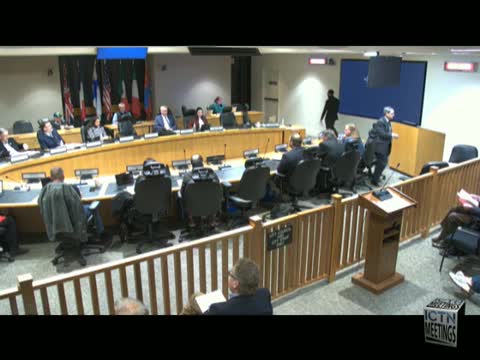City staff proposes requiring conditional‑use permits for data centers; commissioners press for clearer notice and review timing
January 06, 2025 | Irving, Dallas County, Texas
This article was created by AI summarizing key points discussed. AI makes mistakes, so for full details and context, please refer to the video of the full meeting. Please report any errors so we can fix them. Report an error »

City planning staff brought forward proposed Unified Development Code amendments that would convert data centers from an allowable use in certain districts to a use permitted only by conditional‑use permit (CUP), while retaining the substantive development standards adopted previously.
Staff told the commission the change would not alter the technical development standards (height, setbacks, parking, supplemental standards) but would move the use into a discretionary CUP process in commercial warehouse, light industrial and commercial park districts and any district with an SP‑1 or SP‑2 specifically allowing a data center. The CUP would require public hearings before the Planning & Zoning Commission and City Council and would enable conditions, time limits and revocation if standards or findings are not met.
Staff explained the CUP route would allow periodic review and public testimony, and noted that revocation is possible if violations are not remedied following written notice. Commissioners discussed limitations of time‑limited CUPs for data centers — staff and commissioners said the scale of data‑center infrastructure investment makes temporary approvals impractical — but noted CUPs permit other enforcement options.
Notice and outreach concerns dominated the discussion. Staff said state law (Senate Bill 929) now requires an expanded list of recipients for mailed notice, which could push mailings into the thousands for citywide actions; staff estimated more than 6,000 postcards for a prospective citywide data‑center amendment. Commissioners asked for extra time for mailing and for clearer postcard language and a web page to explain the proposal; staff said the web page and QR code would point recipients to more detailed information.
Why it matters: data centers pose unique issues — noise from generators, heavy electrical service and community concerns about clustering and impacts on quality of life. Moving data‑center approvals to a CUP would give the City Council and the public a case‑by‑case posture to address compatibility, though commissioners acknowledged that time limits are generally not practical for these permanent facilities.
Ending: Staff preserved the 300‑foot resident‑distance standard from the existing ordinance and said it will bring the repeal‑and‑replace draft to council for authorization to start the public‑notice process; the commission urged staff to advise council about extending mailing lead times.
Staff told the commission the change would not alter the technical development standards (height, setbacks, parking, supplemental standards) but would move the use into a discretionary CUP process in commercial warehouse, light industrial and commercial park districts and any district with an SP‑1 or SP‑2 specifically allowing a data center. The CUP would require public hearings before the Planning & Zoning Commission and City Council and would enable conditions, time limits and revocation if standards or findings are not met.
Staff explained the CUP route would allow periodic review and public testimony, and noted that revocation is possible if violations are not remedied following written notice. Commissioners discussed limitations of time‑limited CUPs for data centers — staff and commissioners said the scale of data‑center infrastructure investment makes temporary approvals impractical — but noted CUPs permit other enforcement options.
Notice and outreach concerns dominated the discussion. Staff said state law (Senate Bill 929) now requires an expanded list of recipients for mailed notice, which could push mailings into the thousands for citywide actions; staff estimated more than 6,000 postcards for a prospective citywide data‑center amendment. Commissioners asked for extra time for mailing and for clearer postcard language and a web page to explain the proposal; staff said the web page and QR code would point recipients to more detailed information.
Why it matters: data centers pose unique issues — noise from generators, heavy electrical service and community concerns about clustering and impacts on quality of life. Moving data‑center approvals to a CUP would give the City Council and the public a case‑by‑case posture to address compatibility, though commissioners acknowledged that time limits are generally not practical for these permanent facilities.
Ending: Staff preserved the 300‑foot resident‑distance standard from the existing ordinance and said it will bring the repeal‑and‑replace draft to council for authorization to start the public‑notice process; the commission urged staff to advise council about extending mailing lead times.
View full meeting
This article is based on a recent meeting—watch the full video and explore the complete transcript for deeper insights into the discussion.
View full meeting
